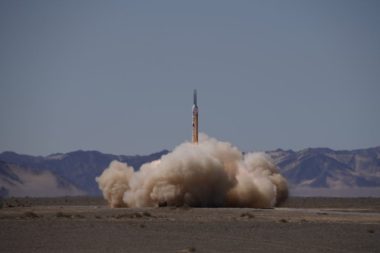Chinese Startups OneSpace, iSpace Succeed With Suborbital Launches

HELSINKI — Chinese launch startup OneSpace successfully performed its first launch from a national launch site Sept.7, following a similar feat by competitor iSpace days earlier.
The 9-meter tall, 0.85-meter-diameter OS-X1 solid rocket lifted off from the Jiuquan Satellite Launch Center at 12:10 a.m. Eastern Sept. 7 (04:10 UTC), reaching an altitude of around 35 kilometers and traveling 169 kilometers during its 200-second flight.
The company claims the OS-X1, also known as Chongqing Liangjiang Star, can reach an altitude of 500 kilometers, but the flight met requirements of an unnamed customer with the payload also remaining undisclosed.
OneSpace's launch followed a suborbital launch two days earlier by iSpace's Hypebrola-1Z rocke, which is t roughly the same size as the OS-X1. Hyperbola-1Z lifted off 01:00 a.m. Eastern (05:00 UTC) Sept. 5 from the same site at Jiuquan, marking iSpace's second suborbital flight.
The 9-meter-tall, 1-meter-diameter rocket carried three small payloads developed by commercial companies. One of the payloads parachuted to Earth.
Both OneSpace and iSpace were founded following a 2014 Chinese government decision to open the space sector to private capital and encourage investment in areas including commercial launch vehicles and remote sensing satellites.
These and other actors will have gained approval and some level of backing from SASTIND, the state administration overseeing Chinese space activities, while a military-civilian integration strategy has promoted access to required technologies for space startups from defense contractors.
Breaking space news, the latest updates on rocket launches, skywatching events and more!
Lan Tianyi, founder of Ultimate Blue Nebula Co., Ltd., a Beijing-based space consulting company, told SpaceNews that the launches from Jiuquan, a national site, show support from the traditional space industry, allaying concerns from investors that the traditional space industry might close the door on startups.
The launches were also a big boost to the companies, as the flights, "showed that their supply chain and the development capacity were better than expected. The suborbital rockets cannot prove that they had the ability to send satellites into Earth orbit. But in first stage of China launch vehicle startup companies, it still a thing that can be praised," Lan said.
The big test for China's emerging space startups will now be orbital spaceflight, an achievement that would mark a major breakthrough.
Private race to orbit
OneSpace, founded in 2015, said its Sept. 7 flight has helped pave the way — by verifying key technologies including navigation, guidance, control, materials and transport —for a much greater challenge: an orbital flight of a larger, 19-meter-tall, four-stage OS-M1 rocket.
The OS-M1 will be able to carry a 205-kilogram payload to 300-kilometer low Earth orbit (LEO), and 73 kilograms to 800-kilometer Sun-synchronous orbit (SSO). On Aug. 24, second and third stage separation and third-stage engine tests for the were successfully performed.
Beijing-based iSpace, established in 2016, says its first launch of an orbital Hyperbola-1 rocket is expected in the first half of 2019. While OneSpace is focused on solid rockets, iSpace says it plans to build larger, liquid propellant launch vehicles in the future.
Both, however, appear likely to be beaten into orbit by Landspace, which is based in Beijing and has facilities in both Xi'an in the north, and a manufacturing base under construction in Huzhou, east China.
Landspace in late August completed assembly and testing at its Xi'an facility of the Zhuque-1 launch vehicle, a 19-meter-tall, 1.35-meter-diameter rocket with a takeoff mass of 27 metric tons and thrust of 45 tons, able to carry 200 kilograms to 500-kilometer SSO and 300 kilograms to a 300-kilometer low Earth orbit.
Launch is now expected to take place in Octoberfrom the Jiuquan Satellite Launch Center, carrying a small remote sensing satellite for China Central Television (CCTV) into SSO.
Orbital launch of Haiyang-1C satellite
Earlier at the Taiyuan Satellite Launch Center, north China, the country's 24thlaunch of 2018 was carried out, seeing a Long March 2C place the Haiyang-1C marine-observation satellite into a 770 by 786-kilometer altitude SSO.
Launch occurred at 23:15 EDT Sept. 6 (03:15 UTC Friday), just ahead of the opening of a launch window declared by an airspace closure notice issued Thursday.
The China Aerospace Science and Technology Corporation (CASC), the main space program contractor, confirmed success of the launch within the hour.
Haiyang-1C is the country's third marine-observation satellite and will help monitor ocean color and water temperatures and contribute to research on the global oceanic environment, according to state media.
According to Chinese sources, the China Academy of Launch Vehicle Technology (CALT), tested use of a parafoil on one-half of the Long March 2C payload fairing, resulting in a more accurate, controlled landing.
CALT, which belongs to CASC, has, in recent years, initiated work on soft-landings reusability of launch vehicles. Three of China's four launch sites are inland, with launches resulting in stages, boosters and payload fairings landing downrange, requiring evacuations ahead of time and other measures. CALT is aiming to test fly the Long March 8 with a reusable first stage in 2021.
This story was provided by SpaceNews, dedicated to covering all aspects of the space industry.

Andrew is a freelance space journalist with a focus on reporting on China's rapidly growing space sector. He began writing for Space.com in 2019 and writes for SpaceNews, IEEE Spectrum, National Geographic, Sky & Telescope, New Scientist and others. Andrew first caught the space bug when, as a youngster, he saw Voyager images of other worlds in our solar system for the first time. Away from space, Andrew enjoys trail running in the forests of Finland. You can follow him on Twitter @AJ_FI.

